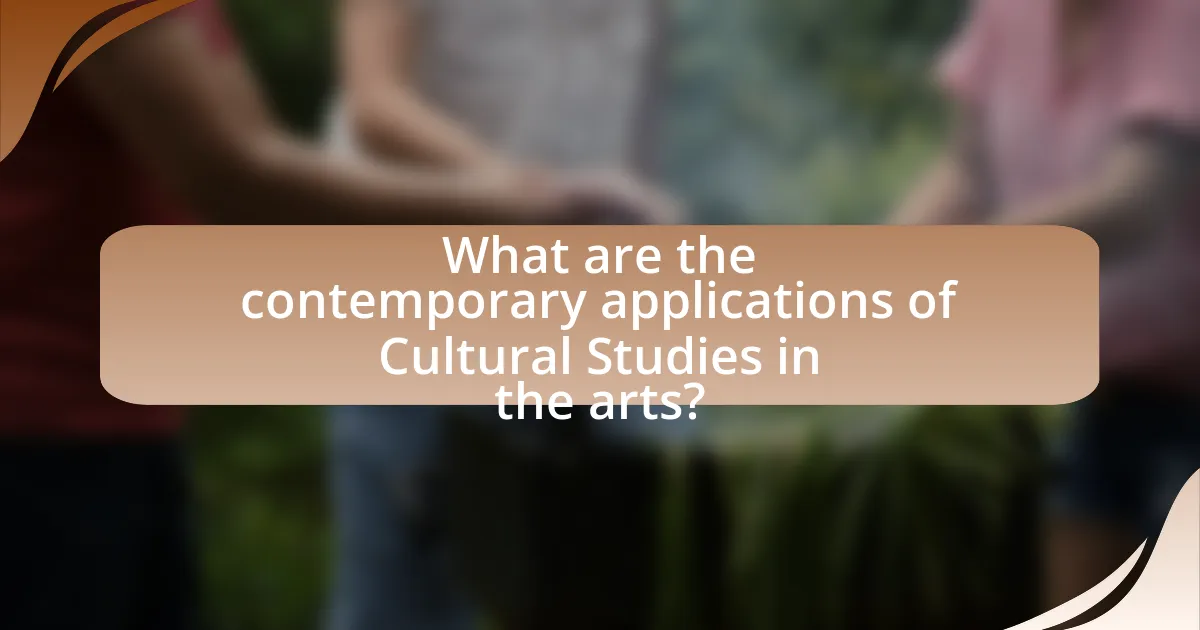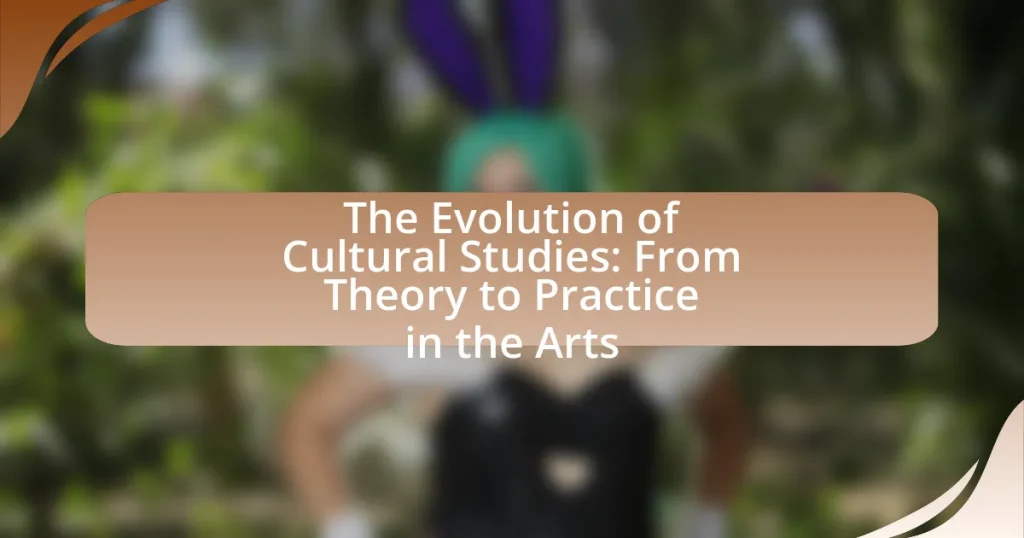The article examines the evolution of Cultural Studies within the arts, tracing its development from a focus on high culture to an inclusive analysis of popular culture and everyday life. It highlights the emergence of Cultural Studies as a discipline in the mid-20th century, influenced by key theorists and historical contexts, and discusses foundational theories such as Marxism, feminism, and postmodernism. The article also explores the methodologies used in Cultural Studies, the challenges faced in its implementation, and its contemporary applications in addressing social issues through artistic expression. Additionally, it considers future directions for Cultural Studies in the arts, emphasizing the role of technology and interdisciplinary collaboration in shaping cultural narratives.

What is the Evolution of Cultural Studies in the Arts?
The evolution of cultural studies in the arts has transitioned from a focus on high culture and elite art forms to a broader examination of popular culture and everyday life. Initially, cultural studies emerged in the mid-20th century, influenced by theorists like Raymond Williams and Stuart Hall, who emphasized the importance of context, ideology, and power relations in understanding cultural phenomena. This shift allowed for the inclusion of diverse voices and practices, recognizing the significance of race, gender, and class in artistic expression. By the late 20th century, cultural studies expanded to incorporate interdisciplinary approaches, integrating insights from sociology, anthropology, and media studies, thereby enriching the analysis of art within its social and political contexts. This evolution reflects a growing recognition of the arts as a dynamic site for cultural negotiation and identity formation.
How did Cultural Studies emerge as a discipline?
Cultural Studies emerged as a discipline in the mid-20th century, primarily influenced by the Birmingham School in the UK, which sought to analyze culture through a critical lens. This school of thought integrated various fields, including sociology, literary theory, and media studies, to understand the complexities of culture in relation to power, identity, and social change. Key figures such as Richard Hoggart and Stuart Hall played pivotal roles in establishing Cultural Studies as a formal academic discipline, emphasizing the importance of popular culture and its impact on society. The establishment of the Centre for Contemporary Cultural Studies at the University of Birmingham in 1964 marked a significant institutionalization of the field, providing a platform for interdisciplinary research and critical inquiry into cultural phenomena.
What historical contexts influenced the development of Cultural Studies?
The development of Cultural Studies was influenced by several historical contexts, including post-World War II social changes, the rise of the civil rights movement, and the emergence of countercultural movements in the 1960s. Post-World War II, there was a significant shift in societal norms and values, leading to increased interest in identity, race, and class, which became central themes in Cultural Studies. The civil rights movement highlighted issues of race and representation, prompting scholars to examine cultural texts through the lens of power dynamics and social justice. Additionally, the countercultural movements of the 1960s challenged traditional authority and norms, fostering a critical approach to culture that emphasized the role of popular media and everyday life in shaping social realities. These contexts collectively shaped the interdisciplinary nature of Cultural Studies, integrating insights from sociology, anthropology, and literary criticism.
How have key theorists shaped the field of Cultural Studies?
Key theorists have significantly shaped the field of Cultural Studies by introducing critical frameworks that analyze culture through various lenses, such as ideology, power dynamics, and identity. For instance, Stuart Hall’s work on encoding and decoding media messages has provided a foundational understanding of how audiences interpret cultural texts, emphasizing the active role of viewers in meaning-making. Similarly, Michel Foucault’s theories on power and discourse have influenced Cultural Studies by highlighting how cultural practices are intertwined with social power structures, thereby encouraging scholars to examine the relationship between culture and societal norms. Additionally, Pierre Bourdieu’s concept of cultural capital has offered insights into how social class affects cultural consumption and production, further enriching the field’s analytical tools. These theorists have collectively established a multidisciplinary approach that integrates sociology, anthropology, and media studies, thereby expanding the scope and depth of Cultural Studies as a discipline.
What are the foundational theories in Cultural Studies?
Foundational theories in Cultural Studies include Marxism, Structuralism, Post-Structuralism, Feminism, and Cultural Materialism. Marxism, articulated by Karl Marx, emphasizes the role of economic power and class struggle in shaping culture. Structuralism, influenced by Ferdinand de Saussure, focuses on the underlying structures that govern cultural phenomena. Post-Structuralism, associated with thinkers like Michel Foucault, critiques the fixed meanings in texts and highlights the fluidity of interpretation. Feminism examines the representation and roles of gender in culture, advocating for the analysis of power dynamics. Cultural Materialism, developed by Raymond Williams, stresses the importance of material conditions and social practices in understanding cultural production. These theories collectively provide a framework for analyzing cultural texts and practices, illustrating the interplay between culture, power, and society.
What role does Marxism play in Cultural Studies?
Marxism plays a foundational role in Cultural Studies by providing a critical framework for analyzing the relationship between culture and power structures. This theoretical approach emphasizes the influence of economic factors on cultural production and consumption, highlighting how class struggles shape cultural narratives and practices. For instance, Marxist theorists like Theodor Adorno and Max Horkheimer critiqued the culture industry, arguing that mass media serves to perpetuate capitalist ideologies, thus influencing public consciousness. This perspective allows Cultural Studies scholars to interrogate how cultural artifacts reflect and reinforce social inequalities, making Marxism essential for understanding the dynamics of culture in relation to societal power.
How do postmodernism and feminism contribute to Cultural Studies?
Postmodernism and feminism significantly contribute to Cultural Studies by challenging traditional narratives and emphasizing the multiplicity of perspectives. Postmodernism introduces the idea that culture is fragmented and constructed through various discourses, which allows for a critical examination of power dynamics and representation in society. Feminism, on the other hand, highlights gender as a crucial factor in understanding cultural production and consumption, advocating for the inclusion of women’s voices and experiences that have historically been marginalized. Together, these frameworks encourage a more inclusive and critical approach to cultural analysis, as evidenced by the works of scholars like bell hooks and Michel Foucault, who explore the intersections of identity, power, and culture.
What is the significance of Cultural Studies in the arts?
Cultural Studies is significant in the arts as it provides a framework for understanding how cultural contexts shape artistic expression and interpretation. This interdisciplinary approach examines the relationships between culture, power, and identity, allowing for a deeper analysis of artworks within their social and historical contexts. For instance, the work of theorists like Stuart Hall emphasizes the importance of representation and the role of cultural narratives in shaping public perception, which directly influences artistic practices. By integrating perspectives from sociology, anthropology, and media studies, Cultural Studies enriches the discourse around art, fostering critical engagement and promoting diverse voices in the artistic landscape.
How does Cultural Studies impact artistic expression and interpretation?
Cultural Studies significantly impacts artistic expression and interpretation by providing frameworks that analyze the relationship between culture, power, and identity. This interdisciplinary approach encourages artists to explore social issues, cultural narratives, and marginalized voices, leading to more diverse and critical artistic practices. For instance, the work of theorists like Stuart Hall emphasizes the importance of representation and the politics of identity, which artists incorporate into their work to challenge dominant narratives. Additionally, Cultural Studies promotes the understanding of art as a social practice, influencing how audiences interpret meaning based on their cultural contexts. This dynamic interaction between culture and art fosters innovative expressions that reflect contemporary societal concerns.
What are the implications of Cultural Studies for understanding cultural artifacts?
Cultural Studies significantly enhances the understanding of cultural artifacts by emphasizing the relationship between culture, power, and identity. This interdisciplinary approach allows for the analysis of artifacts not merely as objects but as products of social contexts, reflecting the values, beliefs, and struggles of specific communities. For instance, the study of popular music within Cultural Studies reveals how genres can express resistance or conformity to societal norms, illustrating the artifact’s role in cultural discourse. Furthermore, Cultural Studies encourages critical engagement with artifacts, prompting questions about authorship, audience reception, and the socio-political implications of cultural production. This framework has been validated through various case studies, such as the examination of graffiti as a form of urban expression, which highlights the intersection of art, politics, and identity in contemporary society.

How has Cultural Studies transitioned from theory to practice?
Cultural Studies has transitioned from theory to practice by integrating critical analysis with real-world applications in various cultural contexts. This shift is evident in the emergence of community-based projects, participatory art practices, and interdisciplinary collaborations that engage with social issues. For instance, scholars and practitioners have utilized ethnographic methods to study and address local cultural dynamics, thereby fostering a direct connection between theoretical frameworks and practical engagement. This evolution is supported by initiatives such as the work of the Birmingham School, which emphasized the importance of cultural context in understanding social phenomena, demonstrating that theoretical insights can inform tangible actions within communities.
What methodologies are used in applying Cultural Studies to the arts?
Cultural Studies employs several methodologies in its application to the arts, including textual analysis, ethnography, and interdisciplinary approaches. Textual analysis allows for the examination of cultural artifacts, such as literature and visual art, to uncover underlying meanings and social contexts. Ethnography involves immersive observation and participation in cultural practices, providing insights into the lived experiences of artists and audiences. Interdisciplinary approaches integrate theories and methods from various fields, such as sociology, anthropology, and media studies, to enrich the understanding of cultural phenomena in the arts. These methodologies collectively enable a comprehensive analysis of how cultural dynamics shape artistic expression and reception.
How do qualitative and quantitative methods inform Cultural Studies research?
Qualitative and quantitative methods inform Cultural Studies research by providing complementary approaches to understanding cultural phenomena. Qualitative methods, such as interviews and ethnography, allow researchers to explore the meanings and experiences behind cultural practices, revealing the complexities of identity and social dynamics. For instance, a study by Clifford Geertz emphasizes the importance of thick description in understanding cultural contexts. Conversely, quantitative methods, including surveys and statistical analysis, enable researchers to identify patterns and correlations within cultural data, offering a broader perspective on trends and behaviors. An example is the use of demographic data to analyze media consumption patterns across different cultural groups, as seen in research by the Pew Research Center. Together, these methods enhance the depth and breadth of Cultural Studies research, facilitating a more nuanced understanding of culture.
What role does interdisciplinary collaboration play in Cultural Studies practice?
Interdisciplinary collaboration is essential in Cultural Studies practice as it enhances the understanding of complex cultural phenomena by integrating diverse perspectives and methodologies. This collaboration allows scholars from various fields, such as sociology, anthropology, literature, and media studies, to contribute their unique insights, leading to a more comprehensive analysis of cultural texts and practices. For instance, the integration of sociological methods can illuminate the social contexts of cultural artifacts, while literary analysis can provide deeper interpretations of narratives. Research has shown that interdisciplinary approaches can yield richer, more nuanced interpretations of cultural issues, as evidenced by studies like “Interdisciplinarity in Cultural Studies” by David Held and Henrietta L. Moore, which highlight the benefits of cross-disciplinary dialogue in producing innovative scholarship.
What are the challenges faced in implementing Cultural Studies in the arts?
Implementing Cultural Studies in the arts faces several challenges, including the difficulty of integrating interdisciplinary approaches, resistance from traditional art institutions, and the complexity of addressing diverse cultural narratives. Interdisciplinary integration is challenging because Cultural Studies draws from various fields such as sociology, anthropology, and history, which can lead to conflicts in methodologies and perspectives. Resistance from traditional art institutions often stems from a reluctance to embrace new theoretical frameworks that challenge established norms and practices. Additionally, the complexity of addressing diverse cultural narratives can create tensions, as artists and scholars must navigate differing cultural contexts and interpretations, making it difficult to achieve consensus on representation and meaning.
How do institutional barriers affect the practice of Cultural Studies?
Institutional barriers significantly hinder the practice of Cultural Studies by limiting access to resources, restricting academic freedom, and enforcing rigid curricula. These barriers manifest in various forms, such as funding constraints that prioritize certain research areas over others, thereby marginalizing diverse cultural perspectives. For instance, universities may allocate budgets that favor STEM fields, resulting in fewer opportunities for Cultural Studies programs to thrive. Additionally, institutional policies can impose strict guidelines on research topics, discouraging critical inquiry into controversial or underrepresented cultural issues. This suppression of academic freedom stifles innovation and the exploration of diverse cultural narratives, ultimately affecting the richness and relevance of Cultural Studies as a discipline.
What are the common misconceptions about Cultural Studies in the arts?
Common misconceptions about Cultural Studies in the arts include the belief that it solely focuses on popular culture and lacks academic rigor. This perspective overlooks the discipline’s comprehensive analysis of cultural phenomena, which encompasses high art, social practices, and historical contexts. Additionally, some assume that Cultural Studies is merely subjective or relativistic, ignoring its methodological frameworks that incorporate critical theory and empirical research. For instance, scholars like Stuart Hall have emphasized the importance of context and power dynamics in cultural interpretation, demonstrating that Cultural Studies employs systematic approaches to understand cultural texts and practices.

What are the contemporary applications of Cultural Studies in the arts?
Contemporary applications of Cultural Studies in the arts include the analysis of identity, representation, and power dynamics within artistic expressions. Cultural Studies scholars examine how art reflects and shapes societal values, often focusing on marginalized voices and cultural narratives. For instance, the rise of intersectionality in art critiques traditional representations by highlighting the experiences of individuals at the crossroads of various identities, such as race, gender, and sexuality. This approach is evident in the works of artists like Kara Walker and Ai Weiwei, who challenge dominant cultural narratives and provoke discussions about social justice. Additionally, Cultural Studies informs curatorial practices, leading to exhibitions that prioritize inclusivity and diverse perspectives, thereby reshaping the art world to be more reflective of contemporary society.
How is Cultural Studies influencing modern artistic practices?
Cultural Studies significantly influences modern artistic practices by providing frameworks that emphasize the relationship between culture, identity, and power dynamics. This interdisciplinary approach encourages artists to explore social issues, challenge dominant narratives, and engage with diverse perspectives. For instance, the incorporation of postcolonial theory in art has led to works that critique colonial histories and represent marginalized voices, as seen in the works of artists like Yinka Shonibare. Additionally, the rise of participatory art practices reflects Cultural Studies’ focus on community engagement and social activism, exemplified by projects that involve local populations in the creative process, thereby fostering dialogue and reflection on cultural identities.
What examples illustrate the integration of Cultural Studies in contemporary art?
Examples illustrating the integration of Cultural Studies in contemporary art include the works of artists like Ai Weiwei and Kara Walker. Ai Weiwei’s installations often address themes of social justice, human rights, and the impact of cultural heritage, reflecting the intersection of art and political discourse. His piece “Sunflower Seeds,” which features millions of handcrafted porcelain seeds, critiques mass production and cultural identity. Similarly, Kara Walker’s silhouettes explore race, gender, and historical narratives, using visual storytelling to challenge societal norms and provoke critical dialogue. These artists exemplify how contemporary art can serve as a platform for cultural critique and reflection, embodying the principles of Cultural Studies by engaging with social issues and cultural contexts.
How do artists utilize Cultural Studies to engage with social issues?
Artists utilize Cultural Studies to engage with social issues by analyzing cultural contexts and power dynamics that shape societal narratives. This approach allows artists to critique and reflect on issues such as race, gender, and class through their work. For instance, artists like Kara Walker and Ai Weiwei incorporate historical and cultural references to challenge dominant ideologies and provoke public discourse. By employing methodologies from Cultural Studies, such as ethnography and critical theory, artists can create works that resonate with contemporary social movements, thereby fostering awareness and encouraging dialogue around pressing social issues.
What future directions can Cultural Studies take in the arts?
Cultural Studies can take future directions in the arts by increasingly integrating interdisciplinary approaches that encompass technology, globalization, and social justice. This evolution is evident as scholars and practitioners explore how digital media reshapes artistic expression and cultural consumption, reflecting the impact of social movements and diverse identities. For instance, the rise of digital platforms has democratized art dissemination, allowing marginalized voices to gain visibility, which aligns with the principles of equity and representation central to Cultural Studies. Additionally, the focus on global interconnectedness encourages the examination of transnational influences on local art forms, fostering a more inclusive understanding of cultural production.
How can Cultural Studies adapt to changing cultural landscapes?
Cultural Studies can adapt to changing cultural landscapes by integrating interdisciplinary approaches that reflect contemporary social dynamics. This adaptation involves analyzing emerging cultural phenomena, such as digital media and globalization, which significantly influence cultural expressions and identities. For instance, the rise of social media platforms has transformed how cultural narratives are constructed and disseminated, necessitating a reevaluation of traditional methodologies in Cultural Studies. By incorporating theories from sociology, media studies, and anthropology, Cultural Studies can remain relevant and responsive to the complexities of modern cultural interactions.
What role will technology play in the future of Cultural Studies in the arts?
Technology will play a transformative role in the future of Cultural Studies in the arts by enhancing accessibility, enabling new forms of expression, and facilitating interdisciplinary collaboration. Digital platforms allow for broader dissemination of artistic works and cultural critiques, reaching diverse audiences globally. For instance, virtual reality and augmented reality technologies are creating immersive experiences that challenge traditional art forms and engage viewers in novel ways. Additionally, data analytics can provide insights into audience preferences and cultural trends, informing artistic practices and academic research. The integration of technology in Cultural Studies is evidenced by the rise of digital humanities, where scholars utilize computational tools to analyze cultural artifacts, thus expanding the scope and methodologies of the field.
What best practices can be adopted for effective Cultural Studies in the arts?
Effective Cultural Studies in the arts can be achieved by adopting interdisciplinary approaches that integrate various fields such as sociology, anthropology, and history. This practice allows for a comprehensive understanding of cultural phenomena and their implications in artistic expressions. For instance, utilizing ethnographic methods can provide insights into the cultural contexts that shape artistic practices, as demonstrated by the work of cultural theorists like Stuart Hall, who emphasized the importance of context in interpreting cultural texts. Additionally, fostering collaboration between artists and scholars can enhance the relevance and impact of cultural studies, as seen in projects that engage communities in the creation and analysis of art. These best practices ensure that Cultural Studies remain dynamic and reflective of diverse cultural narratives.










